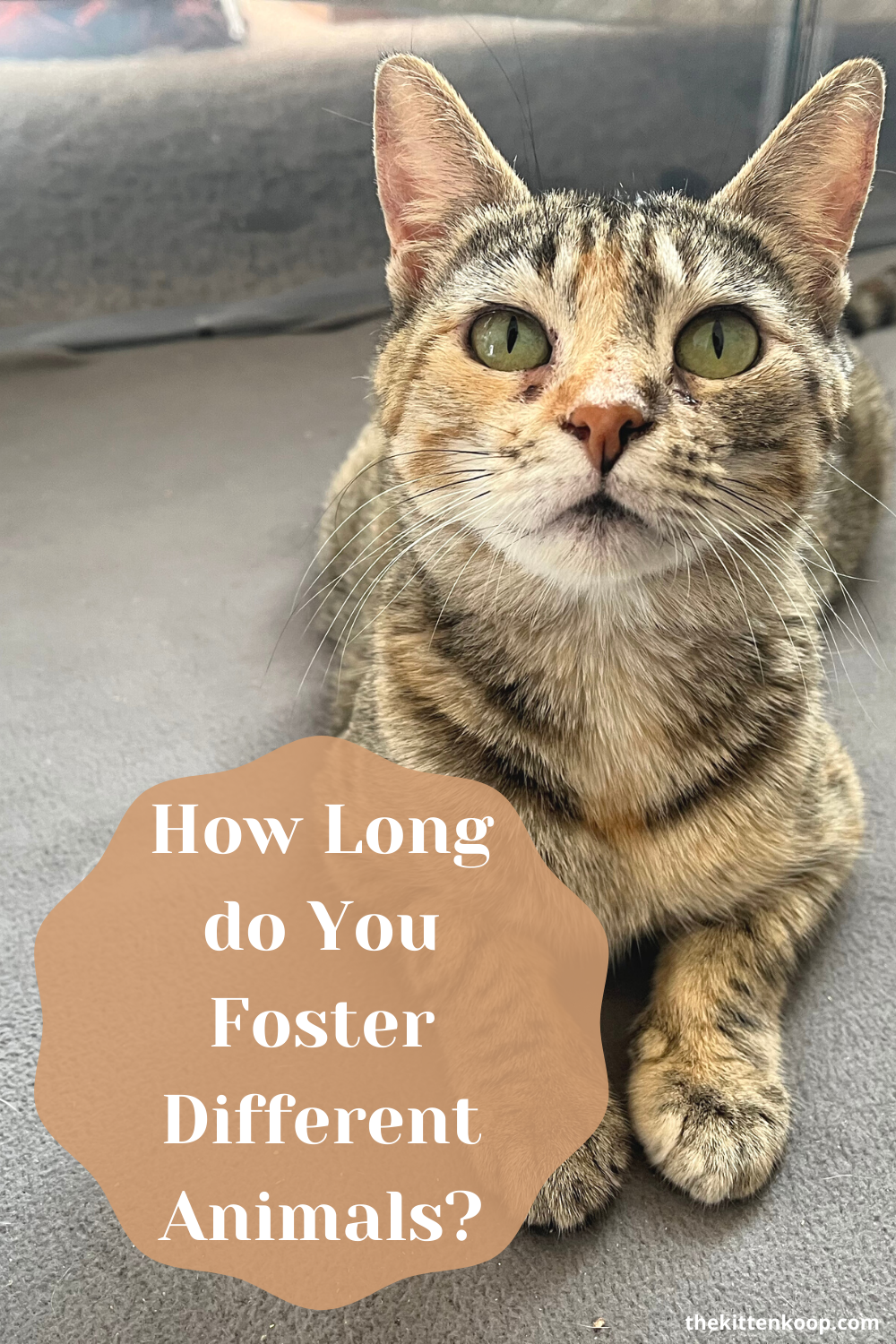Animals of different species, ages, health statuses, and behavioral backgrounds all require different lengths of stay in foster care. Having a wide variety of animal populations in need of foster homes means that there are many different levels of fostering commitments. While some people view this as a convenience, others assume they don’t have time to foster at all. However, everyone can find a group that works for their unique lifestyle. Continue reading to learn about the different factors that determine how long an animal needs a foster home, and hopefully you can find a group you can help.
Species



Different animals have different needs, meaning that the amount of time spent in a foster home varies a bit with the type of animal.
Kittens and cats need foster homes that will care for them until they are healthy and comfortable around humans. They need a place where they can learn how to become a confident housecat!
Puppies and dogs need foster homes that will help them work on obedience training and building their confidence. They need a place where they will have enough time to get used to walking on a leash and going potty outside.
Guinea pigs and other rodents need foster homes to be a place for them to crash until it’s known whether or not they are pregnant. If any babies are born, they need their foster homes to help them raise their young until they’re all old enough to be adopted.
Age


Most animals are not adoptable until they are at least 8 weeks old. For cats and dogs in particular, this is the earliest age that they can be spayed or neutered, which is a requirement of an adoption-ready animal. Puppies and kittens need foster homes as early as the first week of life, so fostering them until they reach adoption age requires a two-month commitment or less.
Older puppies and kittens may just need to work on improving their health and social skills. In this case, they might only be in a foster home for two or three weeks depending on the severity of their needs.
Adult and senior animals do not always get adopted as quickly as younger animals do, depending on the public’s interest. Fostering this age group may be a longer fostering commitment of a few months or up to a year in some cases.
Guinea pigs and other rodents are not adoptable until they are 3 weeks old, so if you foster newborns then that’s the approximate length of your time commitment. If you foster an adult and it’s unknown whether they are pregnant, the fostering commitment will last for a minimum of the species’ gestation period. Guinea pigs in particular have a gestation period of around 2 months.
Health

Animals need to be medically cleared by a veterinarian before they are ready for adoption. They need to have recovered from their sterilization (spay or neuter) surgery and be generally free from illness. Some animals never experience signs of illness in their foster home and are immediately cleared for adoption once they’re sterilized, so their health is not a factor that affects your fostering commitment.
However, if you foster an animal that is recovering from a medical procedure, such as a dental extraction or an enucleation (eye removal), it could be as short as a 1 week commitment. If you foster an animal that is a medical mystery who requires repeat vet visits and several rounds of medication, the commitment could be a month or more.
These examples highlight how health is a factor that significantly affects how long you foster an animal. Since conditions vary widely, animals with medical needs should always be evaluated on a case-by-case basis when it comes to their fostering timeline. If the animal’s medical history is known, make sure you ask questions to see whether or not you will be able to commit to their care regimen.
Please don’t let potential medical cases stop you from fostering. I encourage you to tackle these cases when you’re ready, because watching an animal’s health improve is so rewarding!
Give to our current fosters:
Give to our current fosters:
Give to our current fosters:
Choose an amount
Or enter a custom amount
Any contribution is greatly appreciated!
– $6.00 allows us to buy a bag of litter
– $25 helps us buy 12 cans of cat food
– $100+ allows us to fund general medical procedures for any felines that we foster on our own
Thank you so much for considering a donation! 🙂
Any contribution is greatly appreciated!
– $6.00 allows us to buy a bag of litter
– $25 helps us buy 12 cans of cat food
– $100+ allows us to fund general medical procedures for any felines that we foster on our own
Thank you so much for considering a donation! 🙂
Any contribution is greatly appreciated!
– $6.00 allows us to buy a bag of litter
– $25 helps us buy 12 cans of cat food
– $100+ allows us to fund general medical procedures for any felines that we foster on our own
Thank you so much for considering a donation! 🙂
Behavior

An animal’s behavior significantly affects how long they need to stay in a foster home. The time frame varies widely, because there’s no telling exactly when an unfamiliar animal will be successfully socialized and trained. In some cases, unfamiliar animals will present behavioral issues in their foster homes that arise from fear and stress.
Common behavior concerns that stem from fear and stress are hiding, hissing/growling, and physically aggressive behaviors such as swatting/lunging and biting. Unfortunately, when an animal comes into your home, you don’t always know why the animal exhibits these behaviors. There are many animals, cats in particular, who don’t trust humans for one reason or another. Maybe they were living in a home and experienced abuse or neglect. Maybe they’ve never interacted with humans before and don’t know that humans can be trusted. In either situation, these animals will require lots of time and patience before they’re ready for adoption.
In other cases, the animals you foster will be young enough that they are still in their socialization window. This is a period of time where animals are very impressionable and can therefore quickly adjust to interacting with humans. For kittens, this window closes around 12 weeks of age.
One common scenario is that a kitten under 12 weeks old enters the shelter system and is placed in a foster home that can successfully socialize them. The socialization process can take about a month or less because the kitten is still within their socialization window. Another common scenario is that a kitten older than 12 weeks enters the shelter system and requires a longer period of time to become successfully socialized.
Based on my experience with undersocialized kittens between the ages of 6 weeks and 4 months, please plan for at least a month for young kittens and longer for adults and older kittens.
Adoption

How long you foster an animal ultimately depends on how quickly they get adopted into their forever home. Every factor above affects when an animal will be made available for adoption and how quickly the public will become interested.
It is still more common for people to adopt younger animals. So, younger animals are likely to be adopted pretty quickly once they’re made available. Older animals, typically over a year old, will likely take a while longer to find their perfect forever home. Personalities of older animals are already formed, which has many pros and cons for potential adopters.
To be on the safe side, plan for fostering an animal for at least a month unless specifically told otherwise. Think about it – just one month can save a life! If you know you absolutely cannot commit to a full month, talk to your organization about short-term fostering options like length-of-stay animals and animals needing a place to recover from surgery. If you foster for longer than a month, I promise you that the bond you form and the progress you observe will be worth it in the end! 🙂
Exploring animal welfare one foster kitten at a time


Leave a comment